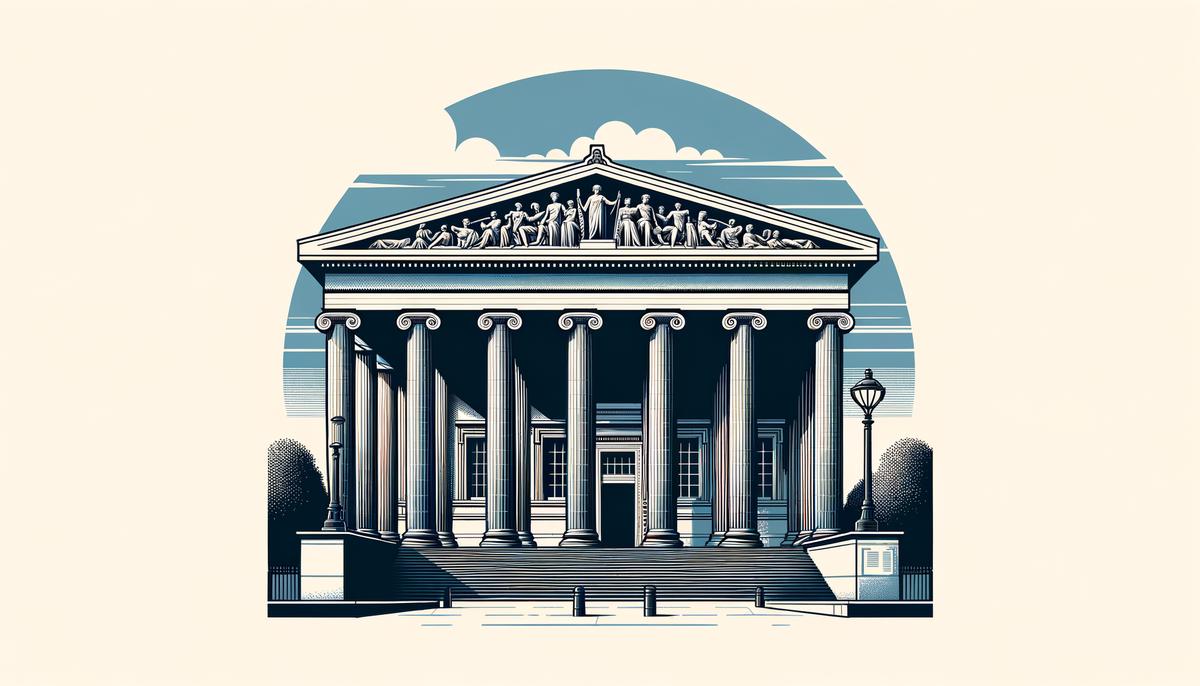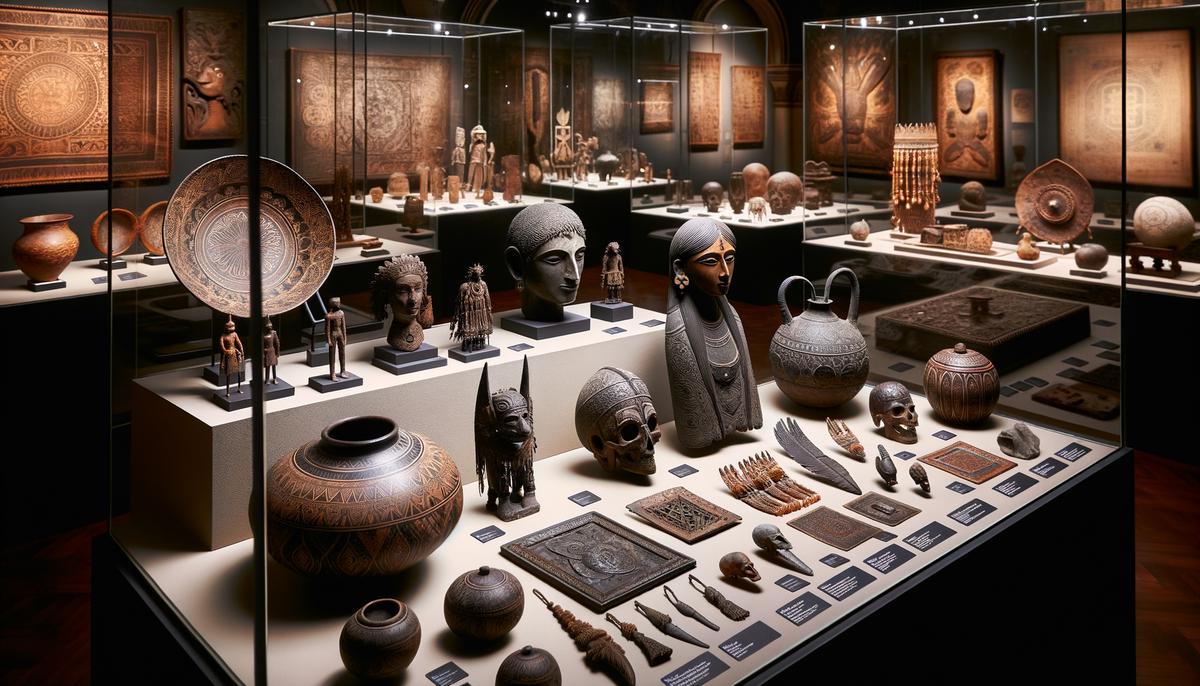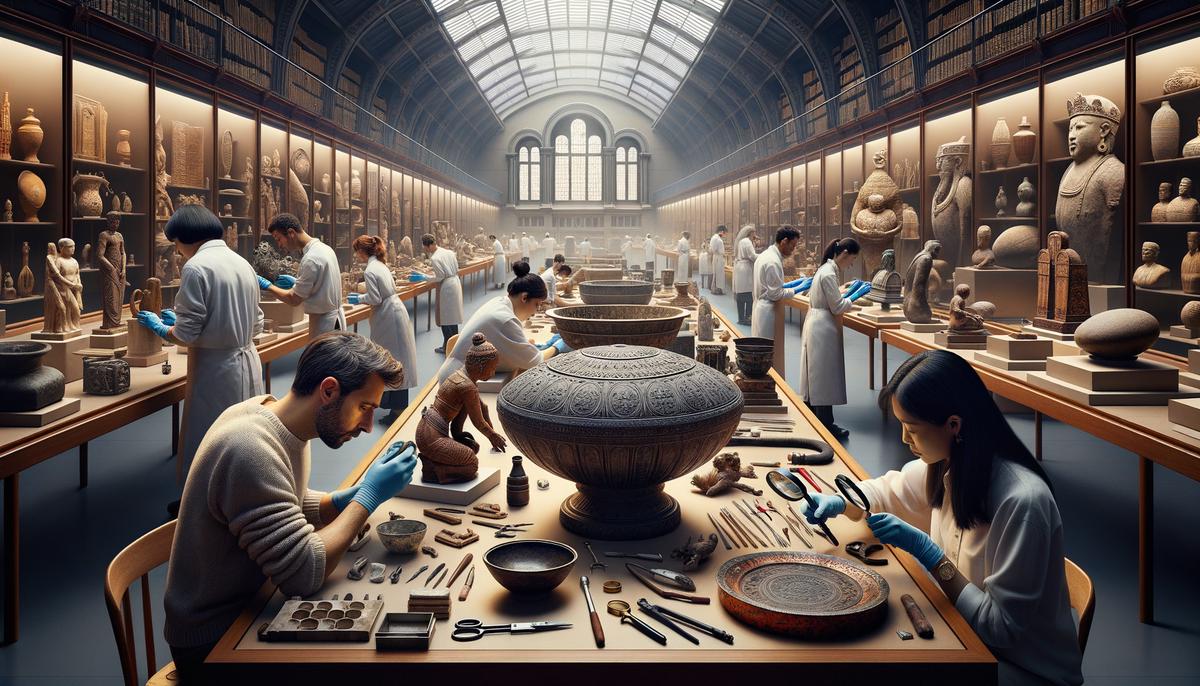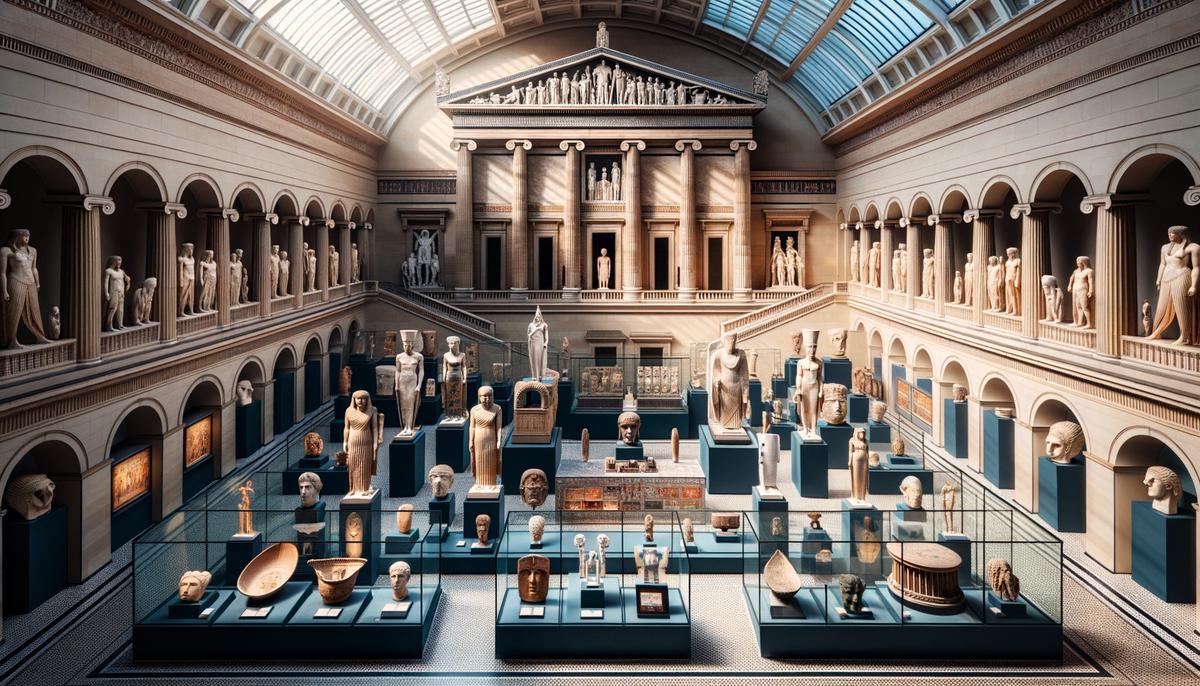The British Museum stands as a testament to the human urge to preserve, understand, and exhibit the rich tapestry of global cultures and histories. From its inception in the 18th century, the museum has grown exponentially, not just in size but in the scope and diversity of its collection. This exploration takes us on a journey through the storied halls of the museum, where each artifact tells a part of our collective story. We’ll uncover how this iconic institution began with modest ambitions but evolved into one of the world’s premier destinations for those eager to connect with the past. Along the way, we’ll meet both the celebrated masterpieces and the lesser-known treasures that lie just beyond the main exhibition paths, all while diving into the day-to-day work that keeps history alive for future generations.
The History and Evolution of the British Museum’s Art Collection
The British Museum stands as a monumental institution in the heart of London, not just as a beacon of British culture but as a global treasure trove of art and antiquities.
How did this museum amass such a renowned collection, spanning continents and epochs, you might wonder? The story is as fascinating as the items within its walls, revealing a history marked by exploration, empire, and a keen eye for the exceptional.
Founded in 1753, the British Museum began with the collection of Sir Hans Sloane, a physician and scientist who had a passion for collecting objects of all kinds. Upon his death, Sloane bequeathed his entire collection to King George II for the nation, in exchange for a payment to his heirs. This act of generosity laid the foundation of the museum, initially housed in Montagu House, Bloomsbury. Sloane’s collection was not just vast but varied, featuring over 71,000 items including books, manuscripts, natural history specimens, and antiquities from ancient Rome, Greece, Egypt, and the Far East.
- As the British Empire expanded, so did the museum’s collection. The 18th and 19th centuries, eras marked by exploration, colonization, and military conquests, saw a substantial growth in the museum’s holdings. The museum directors and British officials abroad eagerly acquired or were gifted significant pieces. Notable acquisitions include the Rosetta Stone, which unlocked the language of ancient Egypt to the modern world, and the Elgin Marbles, a collection of classical Greek marble sculptures brought from the Parthenon in Athens.
The controversies surrounding some of these acquisitions, such as the ethical considerations of the Elgin Marbles’ removal from Greece, are part of the museum’s complex legacy. These debates reflect the changing attitudes towards imperialism and cultural heritage, underscoring the museum’s role in both preserving and contesting history.
- In the 20th century, the museum continued to refine and expand its collection, emphasizing scholarship and public education. The establishment of the British Museum Act in 1963 and subsequent amendments reinforced its mission to maintain its collections for public benefit. Efforts were made to ensure that acquisitions were ethically sourced, reflecting a shift towards responsible stewardship of cultural artifacts.
Today, the British Museum’s collection encompasses over 8 million objects, illustrating the breadth of human culture from its dawn to the present day. Its global collection is a testament to humanity’s shared heritage, offering insights into the interconnectedness of cultures. The museum remains a place of learning, inspiration, and reflection, visited by millions from around the world.
Access to its vast collection is made possible not only through physical visits but also through digital means, with the museum embracing modern technology to reach a global audience. Through its exhibitions, research, and online resources, the British Museum continues to evolve, ensuring its relevance in a rapidly changing world.
The story of the British Museum’s collection is one of curiosity, exploration, and sometimes controversy. It stands as a global treasure not simply for the objects it houses but for the stories they tell and the dialogues they inspire about our past, present, and future.

Iconic Pieces and Hidden Gems in the British Museum
Diving deeper into the labyrinth of the British Museum, it becomes clear that while the Rosetta Stone and the Elgin Marbles grab the spotlight, the museum houses an array of must-see artifacts and lesser-known treasures that offer a personalized journey through human history. Let’s explore some of these hidden gems and the tales they whisper to those who listen closely.
Among the museum’s vast collection lies the Lewis Chessmen, a group of whimsical, intricately carved medieval chess pieces discovered on the Isle of Lewis in the 19th century. Dating back to the 12th century, these walrus ivory and whale teeth figures not only serve as a testament to the creativity and craftsmanship of the Norse cultures but also tell a story of medieval life, power, and gamesmanship that resonates with visitors of all ages. The expressive faces and detailed attire of each figure provide a unique window into the past, allowing one to ponder the hands that carved them and the minds that strategized over them.
In another corner, the museum houses the Double-Headed Serpent, an Aztec masterpiece that intertwines myth with mastery. Crafted from wood and covered in turquoise mosaic, this artifact symbolizes the duality of life and death, creation and destruction, embodying the complex cosmology of the Aztec world. The serpent’s eyes, made from conch shell, seem to follow onlookers, providing a tangible connection to the spiritual depth and artistic sophistication of pre-Columbian civilizations.
For those intrigued by the ancient script, the Assyrian Lion Hunt reliefs offer a breathtaking journey back to the Neo-Assyrian Empire around 645 BCE. These alabaster panels, once adorning the walls of King Ashurbanipal’s palace at Nineveh, depict the royal lion hunt in vivid detail, showcasing the power and prowess of the king. The dynamic movement and emotional intensity captured in the reliefs highlight the Assyrians’ artistic achievement and their reverence for the lion as a symbol of nobility and strength.
Not to be overlooked, the modest yet profoundly poignant Warren Cup presents a rare glimpse into private life in Ancient Rome. This silver drinking cup, dating from the 1st century AD, is adorned with scenes of male love, reflecting aspects of Roman social and sexual customs rarely seen in public art. The cup’s exquisite craftsmanship and the boldness of its subject matter make it an essential artifact for understanding the complexity and diversity of human relationships across time.
Lastly, the museum’s lesser-known yet equally fascinating collection of ancient clocks and watches reveals humanity’s perpetual quest to measure and master time. The 16th-century Astronomical Watch, a marvel of horology, combines art, science, and technology in a portable timepiece that offers insights into the day’s length, the phase of the moon, and even the wearer’s astrological prognosis. This collection not only highlights the evolution of timekeeping methods but also reflects the society’s values, innovations, and interactions with the natural world.
While the British Museum’s headline artifacts like the Rosetta Stone offer a direct connection to pivotal moments in history, the lesser-known treasures within its walls invite visitors on a more personal exploration of human creativity, ingenuity, and resilience. These artifacts, each with their own story, underscore the museum’s role as a custodian of not only objects but the intangible heritage of humanity.

Curation and Conservation Efforts
Continuing from where we left off, a cornerstone of the British Museum’s strategy to preserve its vast and varied collection for future generations lies in its cutting-edge conservation techniques. This encompasses a balance of traditional methods honed over centuries and modern technological advancements, ensuring each artifact from the ancient clocks to the Assyrian Lion Hunt reliefs receives tailor-made care.
First off, temperature and humidity control are vital. Too much moisture leads to mold, while too little can cause materials to become brittle. The Museum meticulously monitors the environment in each gallery and storage space, leveraging advanced HVAC systems. This is particularly crucial for sensitive materials like the ancient papyrus scrolls or the finely painted Lewis Chessmen, where even a slight fluctuation could spell disaster.
Lighting, too, receives careful consideration. Excessive light, especially ultraviolet, can fade colors and degrade organic materials. The Museum thus employs LED lighting in many of its exhibits, providing enough light to view the objects without causing harm. For particularly fragile pieces, like the Double-Headed Serpent, lighting is kept minimal, with visitors able to illuminate the case for a better view at the push of a button.
Another aspect is physical support for the artifacts. Many ancient objects were not made to withstand the test of time. The conservation team devises custom supports — from mounts that invisibly cradle a fragile vase to mannequins that provide the exact pressure needed to preserve historic garments. The Warren Cup, for instance, is displayed on a custom stand that minimizes stress on its ancient silver structure.
Cleaning and restoration work is done with the utmost care and precision, often under microscopes, using tools as fine as a single hair. For example, the Assyrian Lion Hunt reliefs, carved in delicate alabaster, are cleaned with specially designed solvents that remove centuries of grime without damaging the stone. Whenever possible, the Museum opts for non-invasive techniques, preserving not just the artifact itself, but the story it tells.
The British Museum also harnesses the power of digital technology, not just for accessibility, but for preservation. High-resolution 3D scanning and photography allow for detailed examination and digital restoration work. This not only aids in understanding and conserving the object but provides a digital archive, safeguarding against loss due to natural disasters or other unforeseen events.
Behind the scenes, the Museum’s conservation team collaborates closely with researchers and scholars, applying insights from materials science, chemistry, and even biology to better understand how these objects were made and how best to preserve them. This interdisciplinary approach sheds new light on ancient techniques and materials, informing conservation practices while adding depth to the narrative each artifact tells.
In sum, the British Museum’s approach to preserving its vast art collections is as multifaceted as the collection itself. From the microscopic analysis of paint pigments to the macroscopic management of the museum environment, each aspect of preservation is handled with a blend of reverence for the past and a forward-thinking embrace of modern technology. Through these efforts, the Museum not only safeguards these treasures but ensures they will continue to educate and inspire for generations to come.

Controversies and Debates Surrounding the Collection
Diving deeper into the controversies and debates surrounding the British Museum’s art collections, one can’t help but grapple with the ethical implications of how these artifacts were acquired and the implications of holding them in the present day. While the museum houses an array of awe-inspiring objects from around the globe, it’s critically important to unpack the dialogue around repatriation and the rightful ownership of these historical pieces.
Repatriation demands have surged to the forefront of the museum’s controversies, with nations calling for the return of culturally and historically significant artifacts. Cases like the Benin Bronzes, spirited away during a British military expedition in 1897, not only question the legality of such acquisitions but also the moral stance of retaining them. Countries argue that these items are fundamental to their heritage and identity, sparking debates that challenge the narratives curated within the museum’s walls.
Furthermore, the provenance of some artifacts raises eyebrows, casting shadows over the legitimacy of their acquisition. Accusations of looting, particularly in conflict zones, have prompted rigorous scrutiny of the museum’s collection practices. This scrutiny extends to legality, questioning whether certain artifacts were rightfully obtained or simply taken under the guise of imperial power.
The museum’s custodianship of globally amassed treasures also ventures into debates surrounding cultural imperialism. Critics argue that retaining such a varied array of artifacts from colonized lands echoes an era of British dominance, suggesting a need to reassess the power dynamics at play. This perspective advocates for a more equitable sharing of cultural heritage, encouraging loans or repatriation to countries of origin as acts of restitution and reconciliation.
Despite these controversies, the British Museum champions its role as a guardian of global history, emphasizing the educational benefit and cross-cultural dialogue fostered by its collections. It touts the importance of a centralized location where people can learn about diverse cultures and histories, arguing that such accessibility contributes significantly to global understanding and unity.
Amid these conflicting viewpoints, the British Museum finds itself at a crossroads between upholding a legacy as a repository of world history and navigating the evolving landscape of cultural sensitivity and ethical stewardship. As debates rage on, the museum’s approach to these challenges remains under close watch, reflecting broader shifts in how societies value and interact with their cultural heritage.

The British Museum serves as a bridge connecting the past, present, and future. Through its expansive collection, the museum not only celebrates the accomplishments of human civilization but also engages in an ongoing dialogue about our shared heritage and its significance. The challenges of preserving such a vast array of cultural artifacts are matched by the museum’s commitment to innovation in conservation and curation. Meanwhile, the debates over the provenance of certain pieces highlight the museum’s central role in discussions about cultural identity, ownership, and restitution. As we’ve seen, the British Museum remains a dynamic institution, continually evolving in response to new discoveries and changing perspectives on history and culture.
























